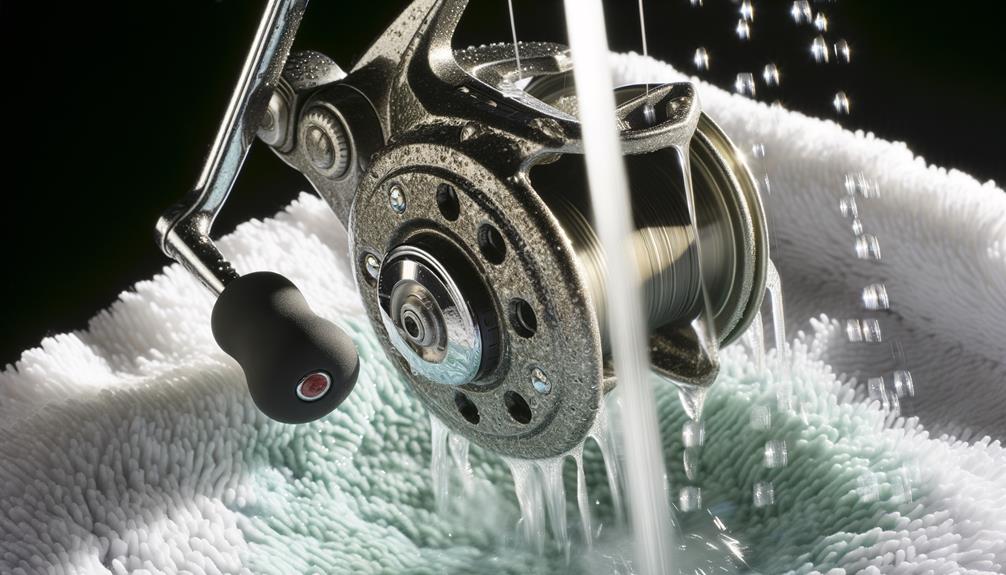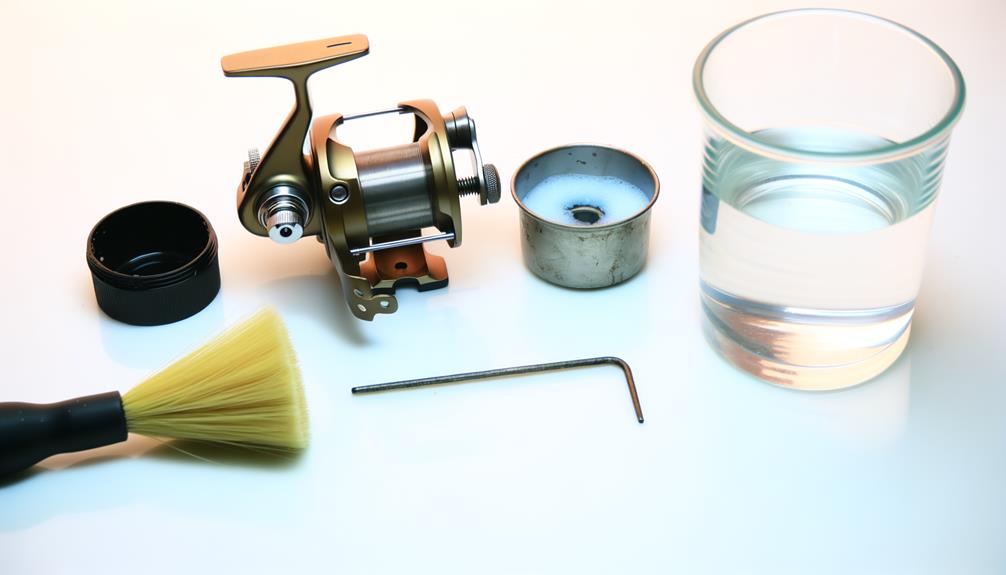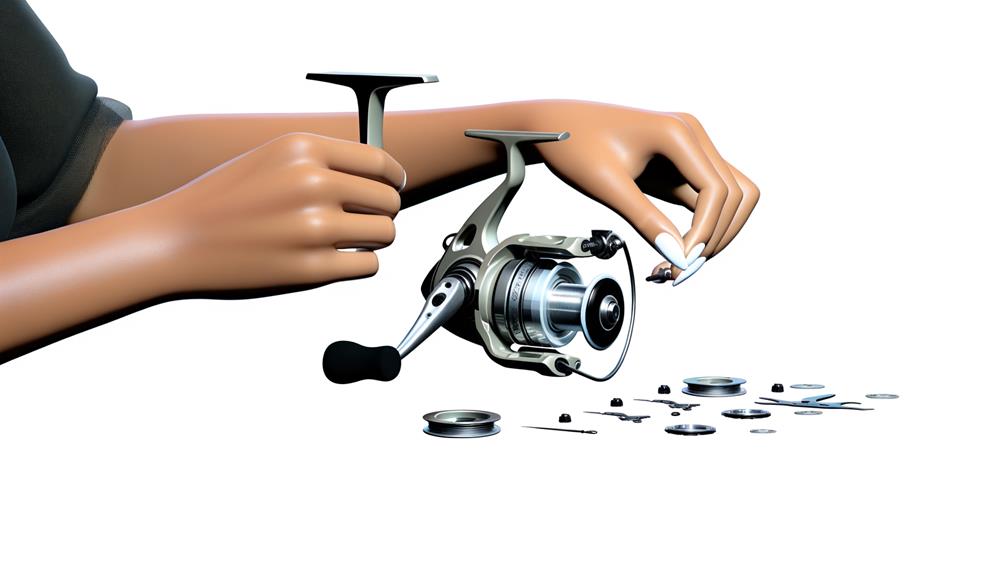As a seasoned angler, you're likely aware that saltwater is corrosive to your fishing gear, particularly your reel. Yet, the importance of properly cleaning your reel after saltwater use cannot be overstated. This process not only prevents corrosion, but also significantly extends the reel's lifespan, while ensuring optimal performance on your subsequent outings.
The process of cleaning might seem straightforward – rinse, scrub, dry, lubricate – but each step holds significant nuances that could be the difference between a well-maintained reel and a damaged one. As we explore this topic, you'll discover the finer details that could enhance your maintenance routine.
Key Takeaways
- Regular cleaning and drying of fishing reels after saltwater use is crucial to prevent corrosive reactions and rust formation.
- Use a soft brush, mild soap, freshwater, and clean cloths to effectively clean and maintain your fishing reel.
- Disassemble, deep clean, and reassemble your reel systematically, whilst keeping an eye out for worn parts or areas needing attention.
- Proper lubrication using reel maintenance kits or manufacturer-recommended lubricants is important for smooth reel operation and avoiding over-lubrication.
Understanding Saltwater Corrosion
To fully appreciate the importance of regular reel maintenance, one must first understand the detrimental effects of saltwater corrosion, a pervasive issue that stems from the corrosive reactions between the salt and the metallic components of the fishing reel. The corrosive elements in saltwater can cause accelerated wear to both the external and internal components of fishing reels. This corrosion can manifest as rust, impairing the reel's performance, and eventually leading to failure.
Understanding saltwater corrosion's insidious nature helps anglers prioritize the correct maintenance tasks. Regular, thorough cleaning of fishing reels after saltwater use is crucial to prevent corrosion. By ensuring that reels are not only clean but also thoroughly dried, corrosion can be effectively mitigated. The process of drying is foundational in preventing rust, as lingering moisture provides an environment conducive to its formation.
Maintenance practices are not just about preserving the functionality of fishing reels, but also about fostering an angler's sense of belonging in the fishing community. Each meticulous cleaning and drying session represents an angler's commitment to the pursuit and respect for the tools that enable it. Regular reel maintenance is therefore an essential ritual in the life of a proficient angler.
Essential Cleaning Equipment
In the pursuit of maintaining a fishing reel after exposure to saltwater, the key tools at an angler's disposal typically include a soft bristle brush, mild soap, a bucket of freshwater, clean cloths, and reel lubricant. These tools are not merely afterthoughts; they are essential components in the process of effectively removing salt residue and dirt from your precious equipment.
The soft bristle brush, in its gentle yet firm application, dislodges salt residue and dirt without causing damage to the reel's components. A mild soap, on the other hand, breaks down stubborn salt deposits and grime. The freshwater bucket serves as your primary rinsing station, ensuring no trace of saltwater residue is left. Clean cloths are used for gentle drying and buffering, while reel lubricant keeps the moving parts of the reel operating smoothly post-cleaning.
Refer to the table below for a summary:
| Essential Cleaning Equipment | Function |
|---|---|
| Soft bristle brush | Removes salt residue and dirt |
| Mild soap | Breaks down salt deposits and grime |
| Freshwater bucket | Rinses off the reel |
| Clean cloths | Dries and buffs the reel |
| Reel lubricant | Lubricates moving parts |
Proper use of these tools will ensure the longevity and high performance of your fishing reel.
Initial Rinse and Dry Process

Immediately after the reel's exposure to saltwater, it is imperative to initiate the initial rinse and dry process to prevent the onset of corrosive damage. This process begins by rinsing the fishing reel under a gentle stream of fresh water. This step neutralizes salt deposits and minimizes their corrosive impact. Be careful not to immerse the entire reel in water as it could force saltwater into the internal parts.
Next, using a soft bristle brush and a mild soap solution, carefully scrub the reel, paying attention to areas where salt residue may have accumulated. Be gentle to avoid damaging the delicate parts of the spinning reel and line. Once you've loosened and removed any visible salt deposits, rinse the reel again thoroughly to wash away any remaining salt and soap.
The next step is to dry the reel completely. Use a clean, dry towel to absorb any excess water, and if necessary, use a hairdryer on a cool setting to ensure that no moisture remains. The reel should be completely dry before applying a reel lubricant. This lubricant not only enhances the reel's performance but also forms a barrier to ward off future corrosion.
Disassembling Your Fishing Reel
Having ensured the reel is thoroughly clean and dry, the next critical step involves disassembling your fishing reel, a meticulous process that requires the right tools and a keen attention to detail. It's crucial to have a clean workspace to keep track of the many small components that make up your spinning reel.
In this process, follow these steps:
- Refer to your manufacturer's instructions or online tutorials for guidance. Each reel model has its unique assembly, and adhering to these guidelines will ensure you disassemble and reassemble your reel correctly.
- Gather your necessary tools. This includes screwdrivers, lubricants, and a clean, well-lit workspace.
- Use a systematic approach in disassembling, keeping track of each part and its position for an easier reassembly process.
- During disassembly, take note of any worn parts or areas that may need special attention.
This process not only ensures the longevity of your reel but also provides an opportunity to familiarize yourself with its inner workings. By cleaning and reapplying lubricants, you're ensuring that your reel will operate smoothly on your next fishing trip. Finally, reassembly should be done with the same attention to detail, ensuring all parts fit together as they should.
Deep Cleaning Each Component

Once your fishing reel is disassembled, a meticulous deep cleaning of each component is paramount to ensure the removal of all salt and debris, thereby prolonging the reel's lifespan and maintaining its performance. This process is crucial after saltwater fishing to prevent corrosion and damage to the reel.
Start with a thorough cleaning of each part, using a soft brush or toothbrush to scrub away any salt and debris delicately. Pay particular attention to the internal components like bearings and gears, which are often the most vulnerable to wear and tear. Inspect these parts for any signs of damage, as early detection can save you costly repairs down the line.
For stubborn dirt and grime that a brush can't remove, soak the smaller parts in a reel cleaning solution. This method is especially effective to clean a spinning reel, as its intricate parts can be challenging to clean manually.
Proper Lubrication Techniques
Applying appropriate lubrication to your fishing reel is a crucial step in its maintenance, particularly focusing on key components such as bearings, gears, and spools. This not only ensures long-lasting performance but also aids in achieving precise casting metrics, facilitated by highly accurate motion capture sensors.
- Begin by disassembling the reel, being mindful to remove the spool assembly to provide access to the internal mechanisms. This process is generally straightforward, particularly with reels such as the Advanced Braking Technology Mg12 Elite, which features an aluminum frame with carbon components for easy maintenance.
- Once disassembled, regularly inspect and reapply lubricant to all moving parts. A reel maintenance kit, or specific lubricants recommended by the reel manufacturer, should be used for best outcomes.
- When lubricating, consider the usage of Bluetooth devices that can help monitor the lubrication process, ensuring even application throughout.
- Lastly, avoid over-lubricating. An excess can attract dirt and debris, which may lead to damage.
Proper lubrication not only ensures the reel's performance but also extends its lifespan. Hence, it's recommended to carry out this maintenance step routinely and methodically.
Reassembling the Fishing Reel

After ensuring optimal lubrication, the next essential step in maintaining your fishing reel's performance and longevity involves meticulous reassembly of the component parts. To facilitate this, you must begin with clean and dry parts. Any residual moisture or grime can significantly hinder the performance of your reel and cause premature wear and tear.
Use your reel schematic as a guide to ensure proper placement of each component. This blueprint is invaluable in avoiding damage from incorrectly positioned parts. Pay particular attention to the drag washers, as any wear or damage here can drastically affect the reel's drag system. Replace any worn-out parts to ensure optimal performance.
When securing the components, tighten screws adequately, but be careful not to overtighten them as this could lead to damage. A delicate balance is necessary here to avoid loose parts that could affect the reel's operation or overly tightened ones that could cause structural damage.
Upon reassembly, be sure to test reel functionality. A smooth operation without any unusual noises or stiffness indicates a successful reassembly. Validate each function as outlined in your reel schematic. This final step ensures your reel is ready for your next fishing adventure, operating at peak performance.
Regular Maintenance Tips
Implementing regular maintenance tips for your fishing reel, particularly after saltwater use, is critical in prolonging its lifespan. This section will provide information on post-fishing reel care, preventive maintenance techniques, and measures to prevent saltwater damage.
Each point will focus on practical, detailed steps to ensure optimal reel performance and longevity.
Post-Fishing Reel Care
Maintaining the longevity and efficiency of your fishing reel necessitates a regular regimen of cleaning and lubrication, particularly after exposure to corrosive saltwater environments. For reels like the One IFC Smart Fishing gear, which employs highly accurate motion capture sensors, or the MegaJaws Elite baitcaster reels with their deep spool design that holds ample fishing line, care is essential.
Here are four steps to follow for post-fishing reel care:
- Clean your reel with a soft bristle brush, mild soap, and freshwater. This applies even to reels with a CNC machined aluminum frame.
- Regularly check and clean the drag washers.
- Apply reel lubricant to moving parts after cleaning.
- Follow the manufacturer's recommendations for cleaning intervals.
Preventative Maintenance Techniques
Effective preventative maintenance techniques for fishing reels, particularly those frequently exposed to saltwater environments, involve regular cleaning and lubrication to stave off corrosion and extend reel longevity. A spinning reel requires special attention to ensure smooth operation.
| Maintenance Step | Description |
|---|---|
| 1. Cleaning | Use a soft bristle brush and mild soap to remove salt residue. |
| 2. Drag Washers | Inspect and clean to ensure optimal function and longevity. |
| 3. Lubrication | Apply to moving parts for smooth operation. |
| 4. Corrosion Prevention | Regular cleaning prevents saltwater-induced corrosion. |
| 5. Manufacturer Recommendations | Follow guidelines for cleaning intervals to maintain reel performance. |
Adherence to these reel maintenance steps will not only enhance your fishing experience but also create a sense of belonging among the angling community.
Saltwater Damage Prevention
An angler's arsenal is incomplete without a well-maintained fishing reel, a task made crucial due to the rapid damage saltwater can inflict on any reel, necessitating immediate post-use cleaning. Saltwater damage prevention is a key part of reel care, especially for your spinning reel after saltwater use.
Here are four regular maintenance tips that can help you prevent corrosion and maintain your reel's longevity:
- Clean your spinning reel: Rinse with fresh water and apply reel oil to all moving parts.
- Air dry: Avoid direct sunlight and allow the reel to dry naturally to prevent further damage.
- Follow manufacturer's recommendations: Adhere to the suggested cleaning intervals to maintain optimal performance.
- Regular Maintenance: Regular cleaning and servicing can extend the life of your fishing reel and prevent saltwater damage. Regular maintenance is not only a preventive measure but also a way to belong to the community of responsible anglers.
Frequently Asked Questions
Should You Wash Reels After Saltwater Fishing?
Yes, washing reels after saltwater fishing is vital. Salt exposure can cause corrosion, requiring reel maintenance for prevention. Proper cleaning, lubrication, and use of protective covers are key. Regular and seasonal care extends reel lifespan.
How Do You Clean Saltwater off a Fishing Reel?
To clean saltwater off a fishing reel, rinse with freshwater, scrub gently with mild soap, and dry thoroughly. Regular lubrication prevents rust. Utilize reel covers, maintenance tools, and professional servicing for optimal care and seasonal storage.
Does Salt Water Damage Reels?
Yes, saltwater can damage fishing reels. Corrosion is a major concern due to salt's impact on material durability. Regular maintenance and lubrication are crucial to extend the reel's lifespan and prevent damage symptoms.
How Do You Take Care of a Saltwater Spinning Reel?
Proper reel maintenance includes thorough cleaning, lubricating vital parts, regular line replacement, careful spool storage, and routine drag system care. Handle upkeep, gear alignment, ball bearings inspection and anti-reverse mechanism checks are also crucial for optimal performance.
Conclusion
In conclusion, the meticulous process of cleaning a fishing reel post-saltwater use encompasses understanding saltwater corrosion, procuring essential cleaning equipment, and mastering the rinse, disassembly, deep cleaning, lubrication, reassembly, and maintenance procedures.
This rigorous regime not only mitigates the corrosive effects of saltwater but also optimizes the reel's functionality, thereby prolonging its lifespan. Therefore, regular adherence to this cleaning protocol emerges as an indispensable practice for every saltwater angler, underpinning successful fishing endeavors.


